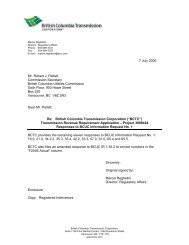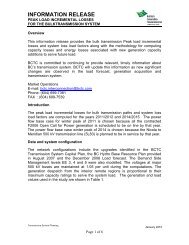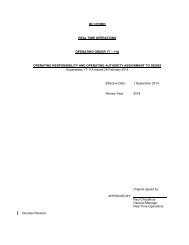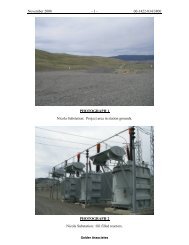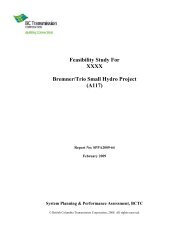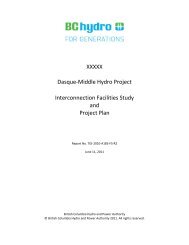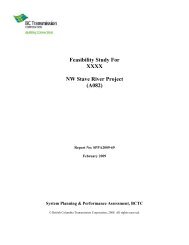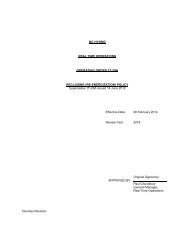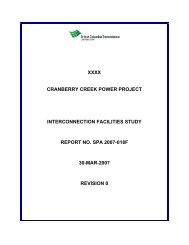Evidence on the Adequacy of First Nations Consultation - BC Hydro ...
Evidence on the Adequacy of First Nations Consultation - BC Hydro ...
Evidence on the Adequacy of First Nations Consultation - BC Hydro ...
Create successful ePaper yourself
Turn your PDF publications into a flip-book with our unique Google optimized e-Paper software.
DRAFT REPORT: Rights and Title Interests in <strong>the</strong> Columbia Valley Transmissi<strong>on</strong> Project Area<br />
In ano<strong>the</strong>r report <strong>the</strong> present authors made a statement c<strong>on</strong>cerning <strong>the</strong> Aboriginal perspective <strong>on</strong><br />
“places <strong>of</strong> cultural significance,” and pointed out what is meant by use <strong>of</strong> <strong>the</strong> term “traditi<strong>on</strong>al<br />
territory”:<br />
It should also be noted, however, that <strong>First</strong> Nati<strong>on</strong>s have a relati<strong>on</strong>ship<br />
with much broader territories than <strong>the</strong> specific sites identified by name.<br />
They used and occupied lands that we refer to comm<strong>on</strong>ly as <strong>the</strong>ir<br />
“traditi<strong>on</strong>al territory.” Their use <strong>of</strong> such territory was not necessarily to<br />
<strong>the</strong> exclusi<strong>on</strong> <strong>of</strong> o<strong>the</strong>r indigenous people, but this territory did c<strong>on</strong>tain<br />
a particular group’s winter villages and customarily-used resourceharvesting<br />
sites. In <strong>the</strong> present report, when we speak <strong>of</strong> a specific area<br />
being within <strong>the</strong> “traditi<strong>on</strong>al territory” <strong>of</strong> a certain people, we mean that<br />
<strong>the</strong> area was used primarily by <strong>the</strong>se people and that <strong>the</strong>y and o<strong>the</strong>r tribes<br />
regarded it as <strong>the</strong>ir territory. Indigenous people associated with o<strong>the</strong>r tribes<br />
may have used <strong>the</strong> same area, provided <strong>the</strong>y made <strong>the</strong>ir presence and<br />
amicable intenti<strong>on</strong>s known, or travelled <strong>the</strong>re as guests <strong>of</strong> <strong>the</strong> resident <strong>First</strong><br />
Nati<strong>on</strong>. While incursi<strong>on</strong> into a neighbouring <strong>First</strong> Nati<strong>on</strong>’s territory and<br />
exploitati<strong>on</strong> <strong>of</strong> <strong>the</strong>ir resources was not uncomm<strong>on</strong>, when d<strong>on</strong>e without<br />
permissi<strong>on</strong> it <strong>of</strong>ten resulted in forceful retaliati<strong>on</strong>. 293<br />
This passage is noted here because a porti<strong>on</strong> <strong>of</strong> it has been cited in <strong>the</strong> July 2009 report entitled<br />
“Tult, Transformati<strong>on</strong> <strong>of</strong> Energy Into Matter,” prepared by Sunny LeBourdais for <strong>the</strong> Lakes<br />
Divisi<strong>on</strong> (“Sexqéltkemc”) <strong>of</strong> <strong>the</strong> Secwepemc Nati<strong>on</strong>. Sunny LeBourdais introduces <strong>the</strong> statement<br />
by saying that resources “were managed by <strong>the</strong> community [and] were accessible by all its<br />
members.” 294 The LeBourdais report also states:<br />
Each ‘Divisi<strong>on</strong>’ or People also had <strong>the</strong> resp<strong>on</strong>sibility <strong>of</strong> defending <strong>the</strong><br />
boundaries <strong>of</strong> <strong>the</strong> Nati<strong>on</strong>. The Secwepemc Nati<strong>on</strong> was well defined in<br />
terms <strong>of</strong> its boundaries and <strong>the</strong> laws governed who were allowed to use<br />
resources within its boundaries.” 295<br />
Thus, it is <strong>the</strong> positi<strong>on</strong> <strong>of</strong> <strong>the</strong> report written <strong>on</strong> behalf <strong>of</strong> <strong>the</strong> Sexqéltkemc that resource<br />
management occurred at <strong>the</strong> band level but that <strong>the</strong> bands coordinated <strong>the</strong>mselves into <strong>the</strong><br />
“Nati<strong>on</strong>.” The study also c<strong>on</strong>cludes that while <strong>the</strong>re “was no chief at <strong>the</strong> Nati<strong>on</strong> level[,] <strong>the</strong><br />
Secwepemc society functi<strong>on</strong>ed as a c<strong>on</strong>federated political entity with representati<strong>on</strong> from each<br />
293 Randy Bouchard and Dorothy Kennedy (2005a). <strong>First</strong> Nati<strong>on</strong>s Aboriginal Interests and Traditi<strong>on</strong>al Use<br />
in <strong>the</strong> Waneta <strong>Hydro</strong>electric Expansi<strong>on</strong> Project Area: A Summary <strong>of</strong> Known and Available Background<br />
Informati<strong>on</strong>. Prepared for Waneta Expansi<strong>on</strong> Power Corporati<strong>on</strong>, Castlegar <strong>BC</strong> (Revised in November 2005 from<br />
<strong>the</strong> August 2004 report with <strong>the</strong> same title). Page 12.<br />
294 Sunny LeBourdais (2009). Tult, Transformati<strong>on</strong> <strong>of</strong> Energy Into Matter. Report prepared for<br />
Sexqéltkemc: <strong>the</strong> Lakes Divisi<strong>on</strong> <strong>of</strong> <strong>the</strong> Secwepemc Nati<strong>on</strong>. Page 6.<br />
295 LeBourdais 2009, page 6.<br />
Bouchard & Kennedy Research C<strong>on</strong>sultants Page 69<br />
Page 72 <strong>of</strong> 200






